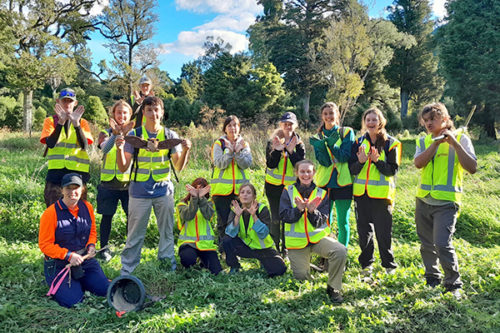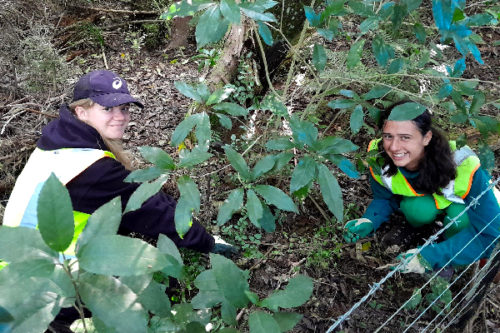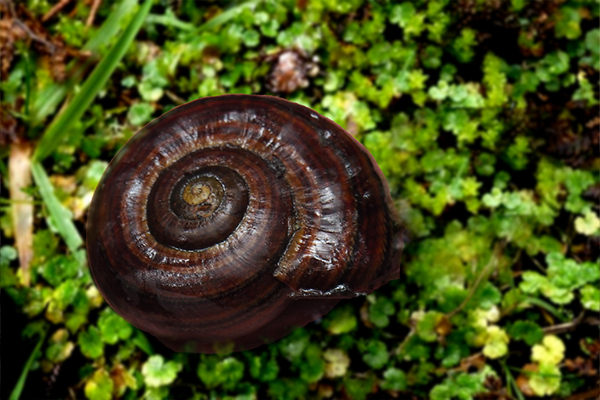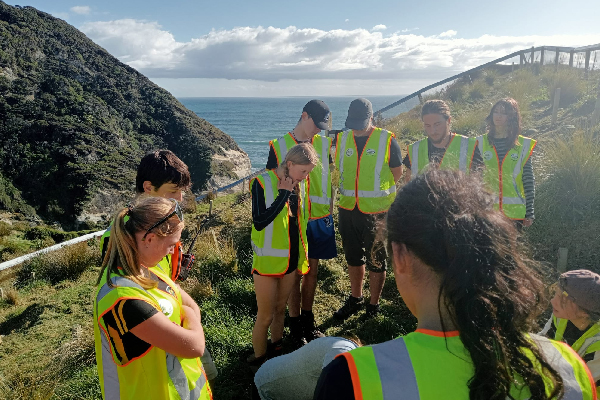A highlight for students on the Environmental Sustainability Trades Programme, was to discover a healthy Powelliphanta snail in a flood-damaged part of the Te Hoiere/Pelorus River Catchment, where it was thought they wouldn’t have survived.
Students spent the first week of this programme in the Te Hoiere/Pelorus River area to build an understanding of kaitiakitanga and what it looks like in practice, including supporting the long-tailed bat recovery project by undertaking predator control by maintaining a trapline in the area, and removing an invasive plant that competes with the natives that when established, are where the bats roost. It was while painstakingly clearing an area of the invasive Chinese privet weed, that the Powelliphanta snail was found.


Rosey Joyce, our lead instructor, said it was really special for the students to find the snail, as they were told that they hadn’t expected any to survive after recent flooding. “It was amazing to see the students immediately connect with our beautiful native snail and realise what it was they were protecting. It helped make sense of all the hard work they had been doing and made it all so worthwhile. The chance to interact with our native species and realise what we’re trying to protect is what the programme is all about.”
Clare O’Rourke, who works for Forest & Bird’s Te Hoiere Bat Recovery Project, was there to support the students in their learning at Te Hoire. “It was a delight to engage with the team and participate in learning in the best classroom there is; outside. I believe spending time in nature is integral to our overall wellbeing. Te taiao benefits too, as curious and optimistic youth grow into motivated conservationists.”
“It was a delight to engage with the team and participate in learning in the best classroom there is; outside. I believe spending time in nature is integral to our overall wellbeing. Te taiao benefits too, as curious and optimistic youth grow into motivated conservationists.” – Clare O’Rourke
Aotearoa is working towards the ambitious goal of being predator free by 2050. With government investment DOC have been investing in new pest control tools and technology, however to be successful in this goal new collaborations from private land owners, Iwi and other organisations are required, as well as innovation and education. The Environmental Sustainability Programme aims to uplift rangatahi in the role of kaitiaki, to help them feel empowered and able to be part of action for our environment, which will be needed to reach the predator free goal.

“The state of our environment can be overwhelming for us all, our programme teaches our young people that they can have a positive impact on the environment,” explains Rosey.
“The state of our environment can be overwhelming for us all, our programme teaches our young people that they can have a positive impact on the environment,” explains Rosey. “The majority of the students on the four-week course had never touched a trap a before, so to see them go from no trapline knowledge to competent to the extent some intend to set up their own traps at home in their back yards, or help on existing projects, is really cool.”
Other highlights for the group so far have included checking and carrying out maintenance on traplines in the Kaiteriteri Mountain Bike Park as well as time spent at the Healthpost Nature Trust eco-sanctuary on Cape Farewell in Golden Bay. The sanctuary features a predator-proof fence to protect a bird nesting site where rare and endangered species such as pāteke (brown teal), diving petrels and fluttering shearwaters are being reintroduced. “It’s been really cool for us to be involved in different levels of trapping, some have technology that we had not seen before like trail cameras and the predator proof fence.” Rosey adds.
“By providing opportunities for students to take their learnings outside of the classroom and into a practical setting, while still gaining the necessary NCEA credits, the students get the chance to connect with the environment and to species that we are trying to protect,” explains Rosey, “They take that sense of connection with them when they leave the course, they feel and understand that they are Kaitiaki – caretakers of the land.”

Rosey says “It’s important to us to help preserve our native species and teach our students that they can have a positive impact on the environment, it’s empowering to see a change in the students’ behaviour as they understand more about biodiversity and become confident working with traplines and other initiatives, it’s really important stuff to learn and I really enjoy getting to be part of this.”
Throughout the programme, Rosey has noted that many of the conservation groups they interact with are of an older generation. Taking students into a local Forest & Bird talk in Golden Bay, someone stood up to publicly thank and acknowledge the Whenua Iti team and the students for their presence. “There was a genuine joy for them to see the younger generation be involved in a community conservation hui. And it made our students feel incredibly proud to be there, and hopefully empowered to stay involved and active for nature.”
***
We’d like to acknowledge and thank everyone who has supported this programme. We’d also like to thank the funders that have supported this programme and our environmental mahi – in particular Top of the South Trades Academy, Department of Conservation Community Fund, Jobs for Nature, WWF, Tindall Foundation and Unlocking Curious Minds. Ngā mihi nui ki a koutou.